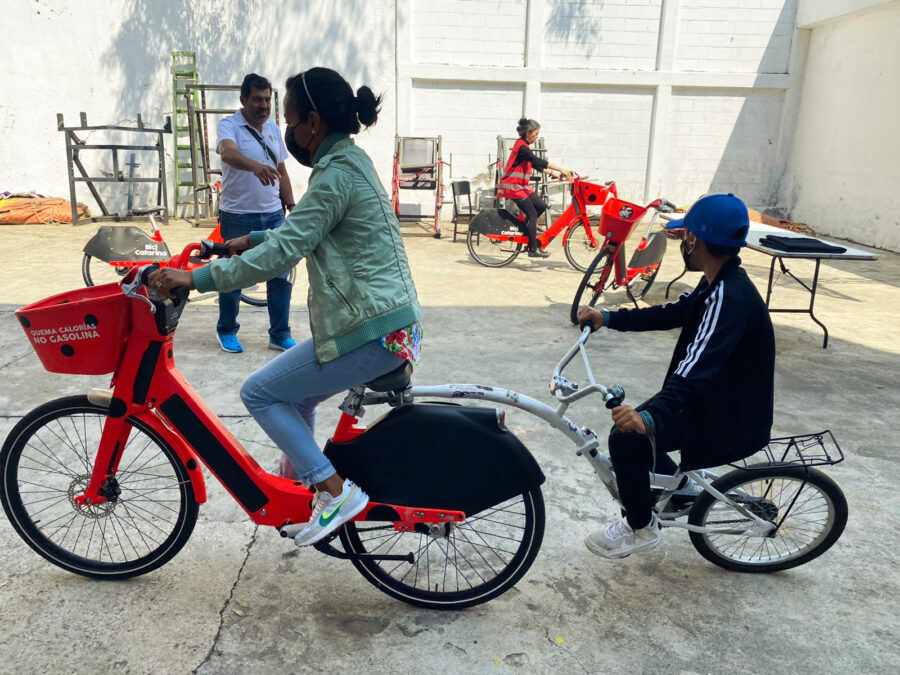6 min. read
Andrea Torres is the Director of Programme Support and Learning at the Bernard van Leer Foundation. With over 20 years of experience managing and implementing social public policies and programmes, and 10 of those working on Early Childhood Development, she has a deep understanding of what it takes for the youngest in our cities to thrive.
–
A child’s brain development from 0-3 years old is critical. What role can Active Mobility play in stimulating healthy Early Childhood Development?
During the first three years of life, the brain is rapidly developing, and active mobility can help to promote this development in a number of ways including both gross and fine motor skills, as well as cognitive development for spatial awareness, problem solving and memory. Active mobility also has positive effects on social and emotional development. When children engage in physical activity with others, they learn important social skills such as communication, cooperation, and sharing. They also experience the emotional benefits of physical activity and outdoor play, such as stress reduction, improved mood, and increased self-esteem. Parents and caregivers can encourage active mobility by providing safe and stimulating environments for children to move and explore, and by engaging in physical activity with them.
Building infrastructure, such as bike lanes, is a crucial step to making cities safe for all to cycle, but does not always cater for the full urban population. Could you expand on the hidden cultural barriers that hinder active mobility
uptake for children and caregivers?
These barriers can include social norms, attitudes, and perceptions about cycling and active mobility, as well as broader cultural and societal factors. One cultural barrier is the perception that cycling is a dangerous activity, particularly for children. Parents may be hesitant to allow their children to cycle or walk to school or other activities due to concerns about safety, even if infrastructure exists.
Another barrier is the belief that active mobility is not a convenient or practical option for families with children. This can be due to factors such as distance or the perception that cycling or walking takes longer than driving. In many urban areas, the design of streets and neighbourhoods prioritises car traffic, making it difficult and sometimes dangerous to walk or cycle. In addition, cultural and societal factors such as gender stereotypes can also impact active mobility uptake. In some cultures, cycling may be seen as a predominantly male activity, and parents may be less likely to encourage their daughters to cycle. This can result in a gender gap in cycling participation, which can perpetuate over time.
Finally, lack of access to bicycles, can also be a barrier to active mobility uptake. This can be a financial issue, with families unable to afford the cost of bicycles or equipment, or a logistical issue, with limited availability of rental or shared bike programs in certain areas.

Image: Bicitekas
Cycling could be an empowering tool for caregiver mobility due to the way they travel. Can you highlight how their mobility differs from other urban dwellers, and how cycling could help?
Caregivers, who are typically responsible for the care of children, often have specific mobility needs that can make traditional modes of transportation challenging. Cycling can offer a number of advantages like providing greater flexibility and control over travel time and routes. Caregivers often need to make multiple stops and adjust their travel plans on short notice, which can be difficult to do with traditional public transportation.
Cycling allows caregivers to travel at their own pace, take direct routes to their destinations, and avoid traffic congestion and delays, and it can be more cost-effective. Caregivers often have limited financial resources, and cycling can offer a low-cost alternative to car ownership or public transportation fares. This can free up resources for other essential expenses such as childcare, medical care, or housing.
Cycling can also offer health benefits for caregivers. Caregiving can be a physically demanding and stressful job, and cycling can provide a low-impact form of exercise that can improve physical health and reduce stress. This can have positive effects on mental health and well-being, which can in turn improve the quality of care provided to others. It can also offer a sense of independence and empowerment allowing caregivers to travel independently and take control of their own mobility needs.
If a family can cycle safely and comfortably, then it is likely that other users will be able to do so too. Can you expand on this idea of “indicator species”?
The concept of “indicator species” in the context of urban design and planning refers to the idea that certain groups of people, such as infants, toddlers, and their caregivers, can be used as a “test” for the quality and safety of urban spaces. If these vulnerable groups are able to navigate a city safely and comfortably, then it is likely that other users, including those with disabilities or the elderly, will be able to do so as well.
This recognises that the built environment can have a significant impact on quality of life and well-being, and that designing urban spaces with the needs of caregivers and young children in mind can improve the overall liveability of a city for everyone.

Image: Bengaluru Moving

